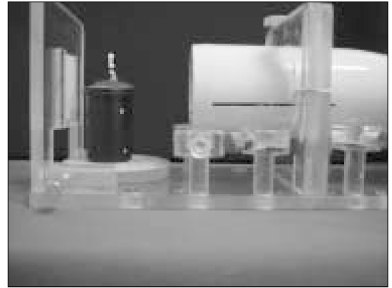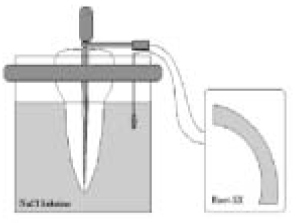J Korean Acad Conserv Dent.
2005 Nov;30(6):477-485. 10.5395/JKACD.2005.30.6.477.
An accuracy of the several electronic apex locators on the mesial root canal of the mandibular molar
- Affiliations
-
- 1Department of Conservative Dentistry, College of Dentistry, Chosun University, Korea. rootcanal@hanmail.net
- KMID: 2175755
- DOI: http://doi.org/10.5395/JKACD.2005.30.6.477
Abstract
- The aim of this study was to compare the length between the mesio-buccal and mesio-lingual canal of the mandibular molars before and after early coronal flaring at the different measuring time using several electronic apex locators. Fifty mandibular molars with complete apical formation and patent foramens were selected. After establishing the initial working length of the buccal and lingual canal of the mesial root using a surgical microscope (Carl Zeiss Co. Germany) at 25X with #15 K-file tip just visible at the foramen, radiographs were taken for the working length. After measuring the length of mesio-buccal and mesio-lingual canal (control group), the electronic lengths were measured at different times using several electronic apex locators (experimental groups; I-Root ZX, II-Bingo, III-Propex, IV-Diagnostic). After early coronal flaring using the K3 file, the additional electronic lengths were measured using the same manner. The results were as follows: One canal has a correct working length for the mesial root of the mandibular molar, it can be used effectively for measuring the electronic working length of another canal when the files are superimposed or encountered at the apex. In addition, the accuracy of the electronic apex locators was increased as the measurement was accomplished after the early coronal flaring of the root canal and the measuring time was repeated.
MeSH Terms
Figure
Cited by 2 articles
-
Study of endodontic working length of Korean posterior teeth
Jeong-Yeob Kim, Sang-Hoon Lee, Gwang-Hee Lee, Sang-Hyuk Park
J Korean Acad Conserv Dent. 2010;35(6):429-435. doi: 10.5395/JKACD.2010.35.6.429.An evaluation of the accuracy of Root ZX according to the conditions of major apical foramen
Shin-Young Park, Dong-Kyun Lee, Ho-Keel Hwang
Restor Dent Endod. 2012;37(2):68-73. doi: 10.5395/rde.2012.37.2.68.
Reference
-
1. Seltzer S, Bender I, Turkenkopf S. Factors affecting successful repair after RCT. J Am Dent Assoc. 1963. 67:651–662.2. Seltzer S, Soltanoff W, Smith J. Periapical tissue reactions of root canal instrumentation beyond the apex. Oral Surg Oral Med Oral Pathol. 1973. 36:725–737.3. Sjogren U. Factors affecting the long-term results of endodontic treatment. J Endod. 1990. 16:498–504.
Article4. Strindberg L. The dependence of pulp therapy on certain factors: an analytic study based on radiographic and clinical follow-up examinations. Acta Odontol Scand. 1956. 14:1.5. Swartz DB, Skidmore AE, Griffin JA Jr. Twenty years of endodontic success and failure. J Endod. 1983. 9:198–202.
Article6. Kuttler Y. Microcopic investigation of root apexes. J Am Dent Assoc. 1955. 50:544–552.7. Altman M, Guttuso J, Seidberg BH, Langeland K. Apical root canal anatomy of human maxillary central incisors. Oral Surg Oral Med Oral Pathol. 1970. 30:694–699.
Article8. Burch JG, Hulen S. The relationship of the apical foramen to the anatomic apex of the tooth root. Oral Surg Oral Med Oral Pathol. 1972. 34:262–268.
Article9. Green D. A stereomicroscopic study of the root apices of 400 maxillary and mandibular posterior teeth. Oral Surg Oral Med Oral Pathol. 1956. 9:1224–1232.
Article10. Green D. Stereomicroscopic study of 700 root apices of maxillary and mandibular posterior teeth. Oral Surg Oral Med Oral Pathol. 1960. 13:728–733.
Article11. Goldman M, Pearson AH, Darzenta N. Reliability of radiographic interpretations. Oral Surg Oral Med Oral Pathol. 1974. 38:287–293.
Article12. Suzuki K. Experimental study on iontophoresis. J Jpn Stomatol. 1942. 16:411–417.13. Sunada I. New method for measuring working lengths of root canal. J Dent Res. 1962. 42:375–378.14. Huang L. An experimental study of the principle of electronic root canal measurement. J Endod. 1987. 13:60–64.
Article15. Seidberg BH, Alibrandi BV, Fine H, Logue B. Clinical investigation of measuring working lengths of root canals with an electronic device and with digital-tactile sense. J Am Dent Assoc. 1975. 90:379–387.
Article16. Fouad AF, Krell KV, McKendry DJ, Koorbusch GF, Olson RA. Clinical evaluation of five electronic root canal length measuring instruments. J Endod. 1990. 16:446–449.
Article17. Kobayashi C, Suda H. New Electronic canal length measuring device on the ratio method. J Endod. 1994. 20:111–114.18. Shabahang S, Goon WWY, Gluskin AH. An in vivo Evaluation of Root ZX Electronic Apex Locator. J Endod. 1996. 22:616–618.19. Caldwell JL. Change in working length following instrumentation of molar canals. Oral Surg Oral Med Oral Pathol. 1976. 41:114–118.
Article20. Stabholz A, Rotstein I, Torabinejad M. Effect of pre-flaring on tactile detection of the apical constriction. J Endod. 1995. 21:92–94.
Article21. Gutierrez JH, Aguayo P. Apical foraminal openings in human teeth. Oral Surg Oral Med Oral Pathol Oral Radiol Endod. 1995. 79:769–777.
Article22. Skidmore AE, Bjorndal AM. Root canal morphology of the human mandibular first molar. Oral Surg Oral Med Oral Pathol. 1971. 32:778–784.
Article23. Pineda F, Kuttler Y. Mesiodistal and buccolingual roentgenographic investigation of 7225 root canals. Oral Surg Oral Med Oral Pathol. 1972. 33:101–110.
Article24. Green D. Morphology of the pulp cavity of the permanent teeth. Oral Surg Oral Med Oral Pathol. 1955. 8:743–759.
Article25. Wheeler RC. Dental Anatomy, Physiology and Occlusion. 1974. 5th ed. W.B. Saunders Co;267–297.26. Woelfel JG, Scheid RC. Dental Anatomy. 2002. 1st ed. philadelphia: Williams & Wilkins;97–107.27. Katz A, Tamse A, Kaufman AY. Tooth length determination: a review. Oral Surg Oral Med Oral Pathol. 1991. 72:238–242.
Article28. Seltzer S, Soltanoff W, Smith J. Biologic aspects of endodontics. V. Periapical tissue reactions to root canal instrumentation beyond the apex and root canal fillings short of and beyond the apex. Oral Surg Oral Med Oral Pathol. 1973. 36:725–737.29. Kim BH, Lee YK, Kim YS. A study on the accuracy of the ROOT-ZX in the canal with mechanically formed constriction. J Korean Acad Conserv Dent. 1999. 24:628–632.30. Czerw RJ, Fulkerson MS, Donnelli JC. An in vitro test of simplified model to demonstrate the operation of electronic root canal measuring devices. J Endod. 1994. 20:605–606.
Article31. Cohen S, Burns R. Pathways of the pulp. 1998. 7th ed. St. Louis: CV Mosby;248–251.32. Kang DH, Chung KH, Yoon SH, Bae KS. An in vitro evaluation of the accuracy of Root ZX electronic apex locator. J Korean Acad Conserv Dent. 1998. 23:339–345.33. Park JH, Roh BD, Lee SJ. The accuracy of the frequency dependent type apex locator. J Korean Acad Conserv Dent. 1996. 21:150–160.34. Kim HJ, Hong CU. In vivo evaluation of accuracy of two electronic apex locators. J Korean Acad Conserv Dent. 1996. 21:289–299.35. Czerw RJ, Fulkerson MS, Donnelly JC, Walmann JO. In vitro evaluation of the accuracy of several electronic apex locators. J Endod. 1995. 21:572–575.
Article36. Dunlap CA, Remeikis NA, BeGole EA, Rauschenberger CR. An in vivo evaluation of an electronic apex locator that uses the ratio method in vital and necrotic canals. J Endod. 1998. 24:48–50.
Article37. Frank AL, Torabinejad M. An in vivo evaluation of endex electronic apex locator. J Endod. 1993. 19:177–179.38. Lauper R, Lutz F, Barbakow F. An in vivo comparison of gradient and absolute impedance electronic apex locators. J Endod. 1996. 22:260–263.
Article39. Ounsi HF, Haddad G. In vitro evaluation of the reliability of the Endex electronic apex locator. J Endod. 1998. 24:120–121.
Article40. Pagavino G, Pace R, Baccetti T. A SEM study of in vivo accuracy of the Root ZX electronic apex locator. J Endod. 1998. 24:438–441.
Article41. Hwang HK, Shin YG, Kim PS. A study on the accuracy of the Root-ZX according to the various conditions of root canals. J Korean Acad Conserv Dent. 2000. 25:474–481.42. Hwang HK, Shin YG. The effectiveness of obturating techniques in sealing isthmuses. J Korean Acad Conserv Dent. 2001. 26:499–506.
- Full Text Links
- Actions
-
Cited
- CITED
-
- Close
- Share
- Similar articles
-
- Evaluating Accuracy according to the Evaluator and Equipment Using Electronic Apex Locators
- In vivo evaluation of accuracy and consistency of two electronic apex locators
- In vitro comparison of measurement accuracy in pre-enlarged and enlarged canals with four apex locators
- The clinical study of the mandibular canal location in mandibular molar areas using dentascan
- Morphology of the apical root canal system in Korean mandibular first molar



